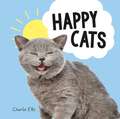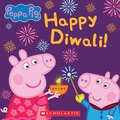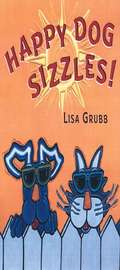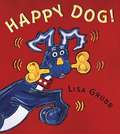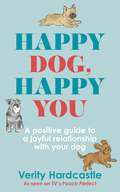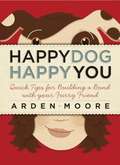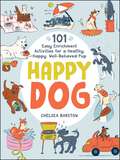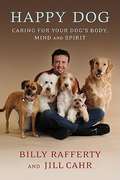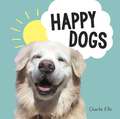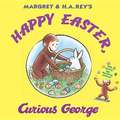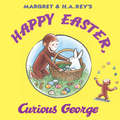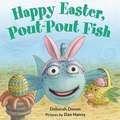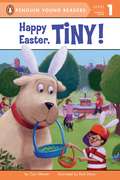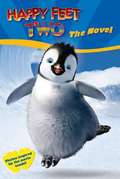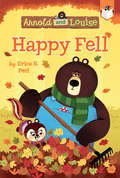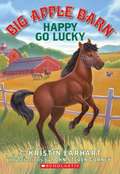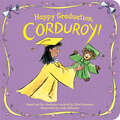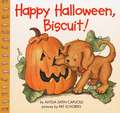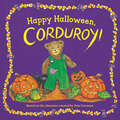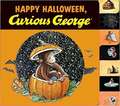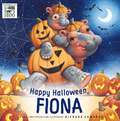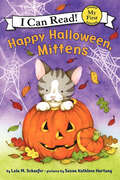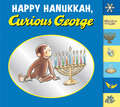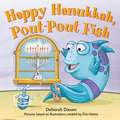- Table View
- List View
Happy Cats: Photos of Felines Feeling Fab
by Charlie EllisFor every cat that hisses and stares at you, there is a happy cat somewhere in the world that would love to receive your attention. A celebration of joyful and jubilant felines, this book is especially crafted for all the cat lovers out there who are desperate to have a puss that loves them back.
Happy Diwali! (Peppa Pig) (Media tie-in)
by EOneCelebrate Diwali with Peppa and her family in this gorgeous storybook with a sheet of stickers! Based on the hit TV show on Nick Jr.It is Diwali and Peppa and her family are learning all about the Festival of Lights. Mummy and Daddy Pig are cooking a feast while Granny and Grandpa Pig bring everyone special clothes to wear. Then it's time for the party to begin! This storybook comes with a fact sheet in the back about Diwali.
Happy Dog Sizzles!
by Lisa GrubbIt's summertime and it's HOT! The pool is packed. There's hardly room enough for a shrimp, much less Happy Dog and Jack Cat. What can these two friends do to cool off? Take matters into their own hands, that' what. A little bit of junk here, a little bit of imagination there, and watch out! (It's walla-pa-doo time.) Full of the bright, bold paintings for which Lisa Grubb is loved world-wide, this follow-up to Happy Dog! Will leave young readers eager to craft their own inventions. And parents smiling at the results.
Happy Dog!
by Lisa GrubbSaturday is Jack Cat's favorite day of the week. But what is he to do when it rains and he can't go out to play with his friends? Paint a new friend, that's what! Meet Happy Dog. Together, these two use their imaginations to fly to outer space, captain a fire engine, and reign supreme over a Swiss cheese castle. And Jack Cat thought he would have to stay in his house all alone! Lisa Grubb's beloved Happy Dog, already a presence on posters and jigsaw puzzles sold around the world, makes his picture-book debut in bold, eye-catching colors. Bring him home for a friend young children will adore.
Happy Dog, Happy You: A positive guide to a joyful relationship with your dog
by Verity HardcastleWant to raise a calm, happy and fulfilled dog?Award-winning groomer, TV personality and experienced dog handler Verity Hardcastle has compiled everything you need to know in this comprehensive dog-care manual: from choosing a breed, to practical diet and nutrition tips and knowing what to buy, to behaviour training and exercise advice... everything you need to fill life with fun and create a joyful friendship with your dog. With a positive focus on mindfulness and wellbeing, Verity shares her expertise as a dog handler and reiki practitioner to help encourage a calm daily routine - this book includes mindful tips and techniques you can try at home or out on walks together. You will also discover how to communicate effectively with your dog, and learn beautiful bonding activities such as massage, meditation and 'doga' (or dog yoga) to build a warm and loving environment in which you can both thrive.This is a must-have for anyone who wants to forge a lasting bond with their four-legged friend. Make both your life and your pooch's happier than ever before! 'If you're considering getting a dog; or have one already and need some advice, this is a great book, full of useful, interesting and practical tips!' - Julian Norton, aka The Yorkshire Vet, veterinary surgeon and author 'If you want to know all about your pooch - fetch this. Inspiring, warm and practical guide to cohabiting with your canine.' - Russell Kane, comedian 'This book is full of practical, heartfelt advice for both new and experienced dog owners. Dogs have long been human's best friend and this book helps us to benefit even more from this relationship. Your furry friend will thank you!' - The Reverend Canon Kate Bottley
Happy Dog, Happy You: A positive guide to a joyful relationship with your dog
by Verity HardcastleWant to raise a calm, happy and fulfilled dog?Award-winning groomer, TV personality and experienced dog handler Verity Hardcastle has compiled everything you need to know in this comprehensive dog-care manual: from choosing a breed, to practical diet and nutrition tips and knowing what to buy, to behaviour training and exercise advice... everything you need to fill life with fun and create a joyful friendship with your dog. With a positive focus on mindfulness and wellbeing, Verity shares her expertise as a dog handler and reiki practitioner to help encourage a calm daily routine - this book includes mindful tips and techniques you can try at home or out on walks together. You will also discover how to communicate effectively with your dog, and learn beautiful bonding activities such as massage, meditation and 'doga' (or dog yoga) to build a warm and loving environment in which you can both thrive.This is a must-have for anyone who wants to forge a lasting bond with their four-legged friend. Make both your life and your pooch's happier than ever before! 'If you're considering getting a dog; or have one already and need some advice, this is a great book, full of useful, interesting and practical tips!' - Julian Norton, aka The Yorkshire Vet, veterinary surgeon and author 'If you want to know all about your pooch - fetch this. Inspiring, warm and practical guide to cohabiting with your canine.' - Russell Kane, comedian 'This book is full of practical, heartfelt advice for both new and experienced dog owners. Dogs have long been human's best friend and this book helps us to benefit even more from this relationship. Your furry friend will thank you!' - The Reverend Canon Kate Bottley
Happy Dog, Happy You: Tips, Tricks, Treats, and Other Quick Ways to Build a Bond with Your Furry Friend
by Arden MooreA wagging tail means unconditional loyalty and love. Most dog owners want to return that affection in every way possible. But some of the common ways humans show love can be downright confusing to our pets - dogs are not furry little people. Even worse, the well-meaning affection that humans shower on their pets can actually reinforce bad dog and cat behaviors. Fortunately, there are plenty of fast, low-fuss rewards that make both pets and people happy while reinforcing proper training and good behavior. In her latest releases, Arden Moore, a best-selling author and one of America's top pet experts, provides busy owners with simple ways to build healthy, harmonious relationships with their beloved dogs. Small adjustments in diet, exercise, and environment can make all the difference in creating better-adjusted pets. Moore offers quick solutions that are simple to execute but often deliver big results. And her suggestions for games and playful training sessions will help owners improve time spent with their furry friends. Happy Dog, Happy You is presented in an easy-to-read, accessible format, and is enhanced with facts, quotes, and colorful call-out boxes, making it the must-have guide for on-the-go owners. With Moore's help, even the busiest dog owner can create a happier hound and enjoy the benefits of a secure, healthy, well-behaved pup.
Happy Dog: 101 Easy Enrichment Activities for a Healthy, Happy, Well-Behaved Pup
by Chelsea BarstowGo beyond training and tricks with enrichment activities to improve your dog&’s mental health from TikTok dog enrichment specialist Chelsea Barstow.It&’s time to take a big step beyond the regular old sit, stay, and roll over with your dog. Canine enrichment can help reduce stress in your dog as well as give them a constructive way to drain their energy. We all know what it&’s like to be bored at home, and with a dog, boredom leads to trouble. With Happy Dog, you will learn simple ways to stimulate your dog&’s mind and keep them occupied whenever they need. From rolling treats in a towel, to playing the Find It game, a variety of lick mats, creating obstacles your dog must navigate, going on an adventure walk, and canine puzzles, there are tons of ways to help keep your dog mentally (and physically) happy and healthy.
Happy Dog: Caring For Your Dog's Body, Mind and Spirit
by Billy Rafferty Jill CahrShow off your happy dog! Every Friday from September 6 - October 2, 2009 the authors will choose a photograph of a happy dog to post on their website and treat the winner to a fabulous prize package. See www.happydogland.com/contest for details.A well cared-for dog is a happy dog. This book goes beyond grooming to explain how the personal touch can make a big difference in a pet's physical and emotional health. From basic first aid to understanding the complete needs of a canine companion, Happy Dog shows pet owners step-bystep how to: * Monitor a pet's health * Set up a stellar home grooming station * Brush, bathe, and dry a panting pal * Dog-proof the home and travel right With his extensive expertise, Billy Rafferty includes invaluable and exclusive features, such as: * A yearly grooming calendar * Appraisals of products and tools on the market * Safety and emergency preparedness tips * Pet nutrition, exercise and play rules * Illustrations and photos throughout--including special appearances by celebrity dogs With the expert knowledge condensed in these pages, reading Happy Dog could be the best thing a dog owner ever does for a furry best friend.
Happy Dogs: Photos of the Happiest Pups and Doggos in the World
by Charlie EllisIt’s a scientific fact that it’s impossible to feel sad while looking at cheerful pups. Let this photographic celebration of the world’s happiest, silliest and most playful pooches put a smile on your face and a wag in your tail.
Happy Easter, Curious George
by Margret ReyGeorge and the man with the yellow hat decide to visit the park on a fine Easter morning. George sees the children in the park enjoying all kinds of activities, including dyeing Easter eggs. George has never dyed eggs before and he can't wait to join in the fun! He enjoys playing with colors and patterns on his eggs, but when he sees a man who seems to be losing decorated eggs, George decides to help as only a monkey can. But wait--can George help find the missing Easter Bunny, too?Includes glittery egg-decorating stickers!
Happy Easter, Curious George (Read-aloud)
by H. A. ReyHappy Easter, Curious George is a winning holiday story based on H. A. and Margret Rey's popular primate and painted in the original watercolor and charcoal style. One fine Easter morning, George and the man with the yellow hat head to the park. George can't help but join in the fun when he sees children dyeing Easter eggs . . . but what's that man doing with their prized creations? For more monkey fun, investigate www.curiousgeorge.com and discover all the latest on Curious George books, promotions, games, activities, and more! The audio for this Read-Aloud ebook was produced and engineered by Perry Geyer at Cybersound Recording Studios (349 Newbury St., Ste. 201, Boston, MA 02115). Music theme composed by Cybersound Studios (Perry Geyer, Silvio Amato, Michael Africk, Greg Hawkes). Engineers: Perry Geyer (music production and sound design), Rob Whitaker (editing and mixing engineer), Samuel Creager (editing, sound design, and mixing engineer), Marcus Clark, Corey Rupp. Assistant engineers: Dave Chapman, Mike Pekarski, Justin Sheriff, Daniel Wrigley, Andrew Sardinha, Mami Ienaga, Kevin Notar, Maria Goulamhoussen. Sheridan Willard, John Huang, John Schmidt. Voiceover by Nikki Lu Lowe.
Happy Easter, Pout-Pout Fish (A Pout-Pout Fish Mini Adventure #8)
by Deborah DiesenA short and sweet mini-adventure especially created to introduce the youngest guppies to the New York Times-Bestselling Pout-Pout Fish series.Hippity-hoppity, the pout-pout bunny is on his way! Toddlers will love swimming along with the pout-pout fish this Easter as he turns little pouts into big smiles. With just one line of text per page, this simple, 12-page board book will send Debbie Diesen and Dan Hanna's much-loved Pout-Pout Fish flippering and swishing into the hearts and minds of the youngest guppies.
Happy Easter, Tiny! (Tiny)
by Cari MeisterJoin Tiny as he hunts for Easter eggs!There's an Easter egg hunt in the park just for dogs, and Tiny can't wait to go with his best friend. But when Tiny begins to search, he can't find a single egg! Once the hunt is over, Tiny does manage to find an adorable, fluffy surprise that makes it one of the happiest Easters ever!
Happy Feet Two: The Novel
by Paul LivingstonHappy Feet Two returns audiences to the magnificent landscape of Antarctica, reuniting the world's most famous tap-dancing penguin, Mumble, the love of his life, Gloria, and their old friends Ramon and Lovelace.In this novel adaptation, which includes full-color images from the film, we meet Erik - Mumble and Gloria's son. Erik is struggling to find his own particular talents in the emperor penguin world. But new dangers are threatening the penguin nation, and it's going to take everyone working - and dancing - together to save their home.
Happy Fell #3 (Arnold and Louise #3)
by Erica S. PerlArnold wants to celebrate the start of the cozy autumn season indoors. Louise does not. How can they celebrate fell if they're not celebrating together? In this story designed to engage early readers, charming characters combine with simple text, lively illustrations, and laugh-out-loud humor to help boost kids' confidence and create lifelong readers!On one brisk, chilly day, Arnold the bear is determined to stay inside and make popcorn balls. But his best friend, Louise the chipmunk, wants to be outside and make leaf piles. After all, the leaves have finally fallen to the ground, bringing the first day of what Louise calls fell, the season between fall and winter. An argument ensues, so they decide to do their preferred activities separately. But when they both realize that one thing is missing--each other--can they find a way to celebrate together?Exciting, easy-to-read books are the stepping stone a young reader needs to bridge the gap between being a beginner and being fluent.
Happy Go Lucky (Big Apple Barn #1)
by Kristin EarhartWELCOME TO BIG APPLE BARN! Happy Go Lucky is a young pony. He loves living with his mom at Shoemaker Stables. But when he's sent to live at a riding school called Big Apple Barn, everything in Happy's life changes. Big Apple Barn is full of new adventures! There are so many horses and ponies for Happy to meet. He has a lot to learn, and he misses his home. Will Happy Go Lucky find his place at Big Apple Barn?
Happy Graduation, Corduroy! (Corduroy)
by Don FreemanIn this new Corduroy board book, Corduroy and Lisa put on their caps and gowns and have a very special graduation day.It's the end of the school year, and Corduroy and Lisa are graduating from kindergarten! Join them and their friends as they prepare for the day, accept their diplomas, and get excited about their next school year. Happy graduation, Corduroy!Perfect for graduations of any age, Happy Graduation, Corduroy! is yet another adventure starring Don Freeman's beloved characters that readers young and old will delight in.
Happy Halloween, Biscuit!
by Alyssa Satin CapucilliWooof! Wooof! Biscuit and the little girl are going trick-or-treating on his first Halloween. What kinds of silly surprises are in store for them? Pull back the flaps to find out!
Happy Halloween, Corduroy! (Corduroy)
by Don Freeman Jody WheelerCome celebrate Halloween with Corduroy in his new holiday board book!Corduroy is excited to celebrate Halloween. Join him as he carves pumpkins, makes candy apples, and dresses in his Halloween costume! This fun, festive story is the perfect gift for little hands. Great for autumn and the Halloween season, children and adults alike will love celebrating Halloween with one of our iconic characters.
Happy Halloween, Curious George
by H. A. ReyHalloween is here, and Curious George is getting ready for the big night. There are so many costumes to try on, treats to share, and games to play! George has so much Halloween fun picking out the perfect pumpkin, decorating his house, and celebrating with his friends that he's not sure he's ready for the day to end. Follow the little monkey through his fun-filled day with this ebook of poems. Happy Halloween, Curious George is a sweet treat to help Curious George fans of all ages get in the Halloween spirit.
Happy Halloween, Fiona (A Fiona the Hippo Book)
by ZondervanJoin your favorite hippo, Fiona, the beloved internet sensation from the Cincinnati Zoo and Botanical Garden, as she heads out from some trick-or-treating Halloween fun with her little brother Fritz and all their animal friends at the zoo! Happy Halloween, Fiona is another addition to the New York Times bestselling Fiona the Hippo series.It&’s Halloween, and Fiona wants to share all the fun with her little brother Fritz. But Fritz isn&’t so sure. It is so dark. And what are those scary screeches and growls all around the zoo? Will Fiona&’s encouragement and the thought of yummy treats and seeing friends in fun costumes be enough to help Fritz be brave?Happy Halloween, Fiona is:A fun adventure about giving encouragement, friendship, and facing fearsThe perfect gift for the fall season or for trick-or-treat bagsGreat for fans of Fiona the Hippo and all zoo animalsIdeals for readers 4-8Part of the beloved Fiona the Hippo book series from New York Times bestselling illustrator Richard Cowdrey Check out these other books in the Fiona the Hippo Series:Fiona, Love at the ZooYou&’ve Got This, FionaFiona Helps a FriendFiona, It&’s BedtimeFiona the HippoA Very Fiona ChristmasHappy Birthday, FionaFiona and the Easter Egg Hunt
Happy Halloween, Mittens (My First I Can Read)
by Lola M. SchaeferMittens the kitten wants to help Nick get ready for Halloween. But when Mittens tries to paint spooky faces, put up spooky cobwebs, and make orange cookies, he makes a mess instead! Halloween activities take center stage in this sweet beginning reader about Mittens.This My First I Can Read Book is perfect for shared reading with toddlers and very young children. Basic language, word repetition, and whimsical illustrations make this book just right for the emergent reader.
Happy Hanukkah, Curious George (Curious George)
by H. A. Rey Margret ReyIt is the eighth night of Hanukkah, and George and his friends have gathered for a celebration. They light the menorah, spin the dreidel, make latkes, and learn the importance of mitzvah! In this ebook, youngsters will even find a tasty latke recipe and instructions for constructing a dreidel, with rules for play.
Happy Hanukkah, Pout-Pout Fish (A Pout-Pout Fish Mini Adventure #11)
by Deborah DiesenDeborah Diesen and Dan Hanna's Happy Hanukkah, Pout-Pout Fish is a short and sweet mini-adventure created to introduce the youngest guppies to the New York Times bestselling Pout-Pout Fish series. Celebrate Hanukkah with Mr. Fish and his friends—it's eight nights of fun! From a delicious meal to lighting the menorah, Hanukkah is a time of joy. Toddlers will love swimming along with the pout-pout fish as he turns little pouts into big smiles in this original board book.
